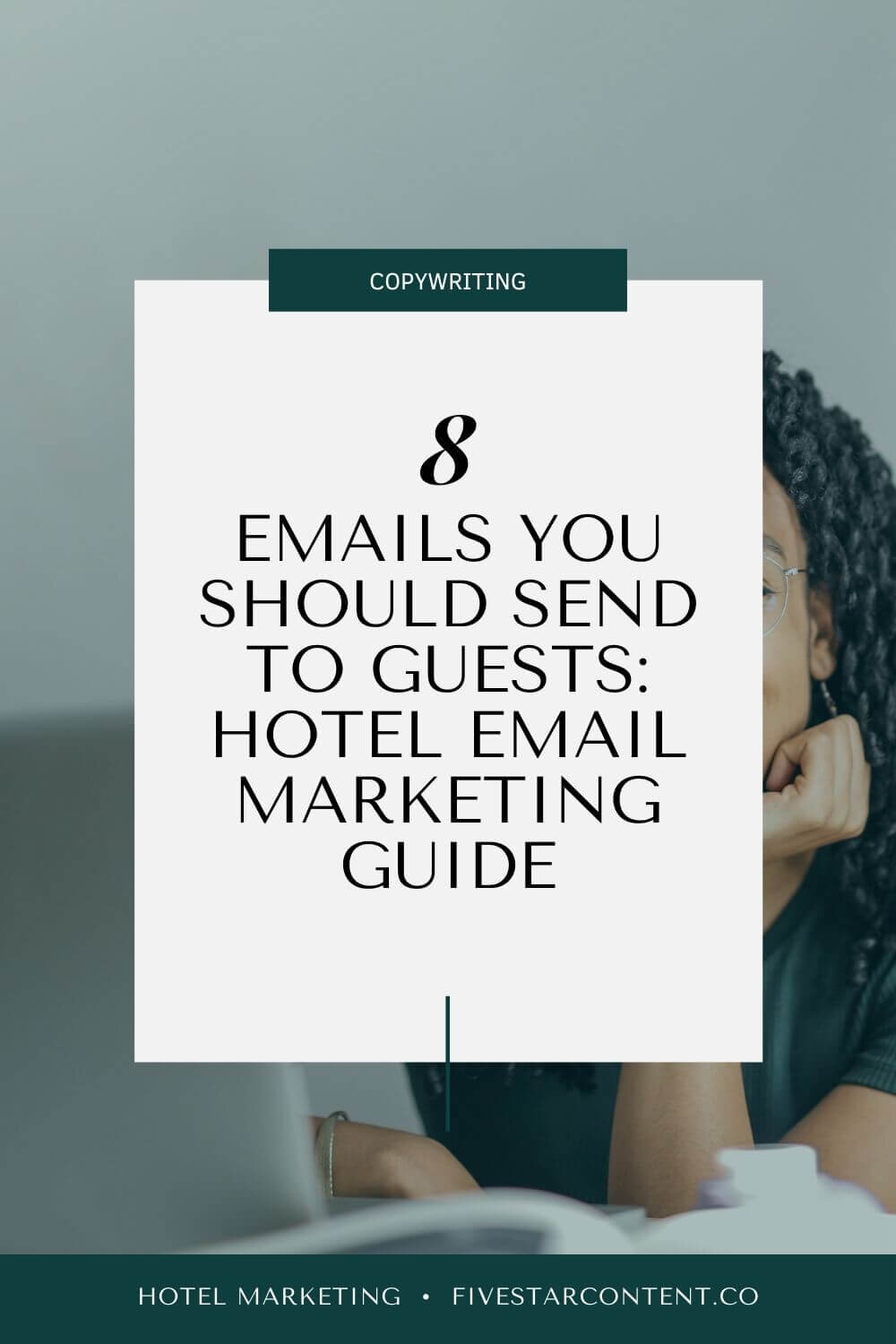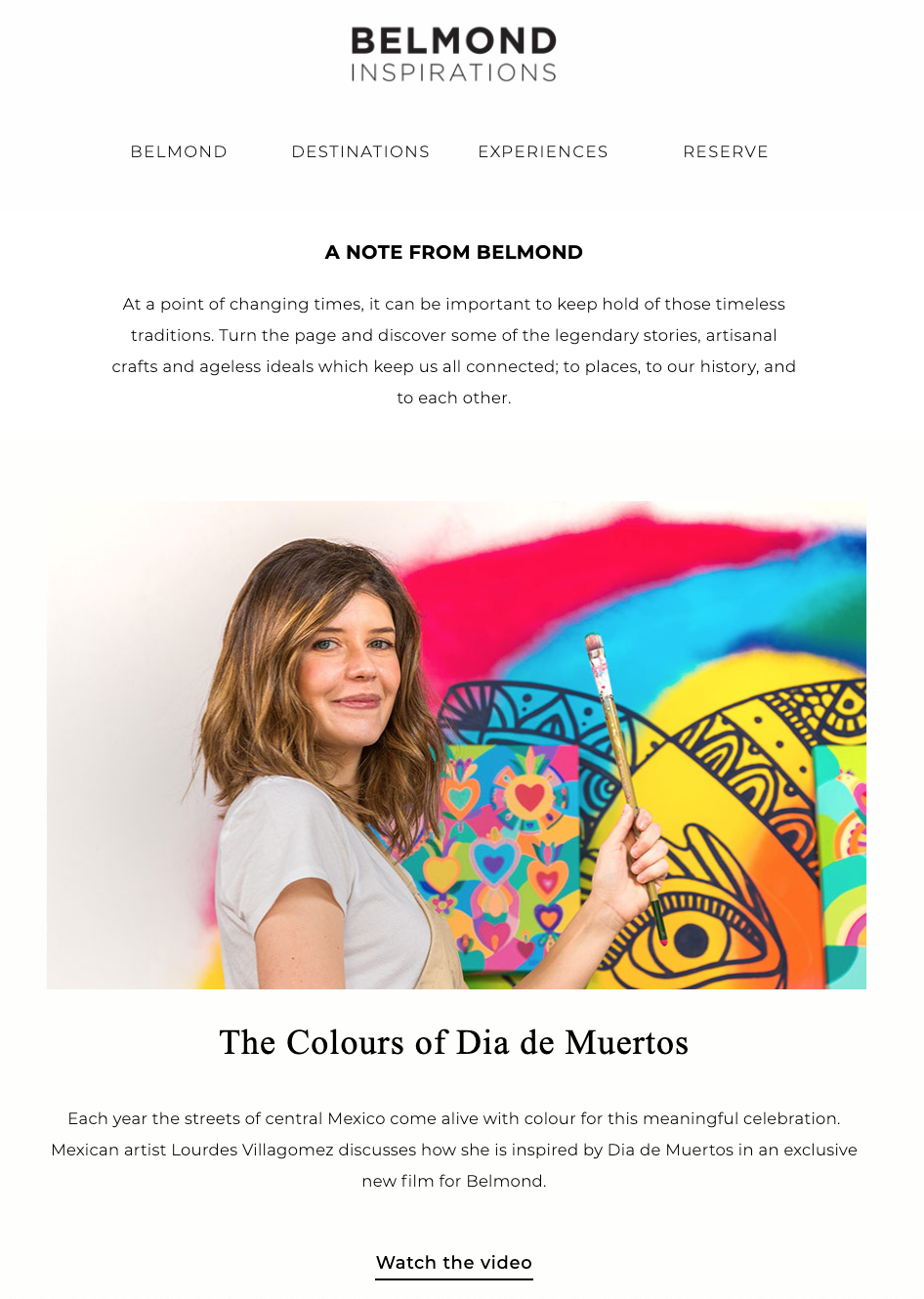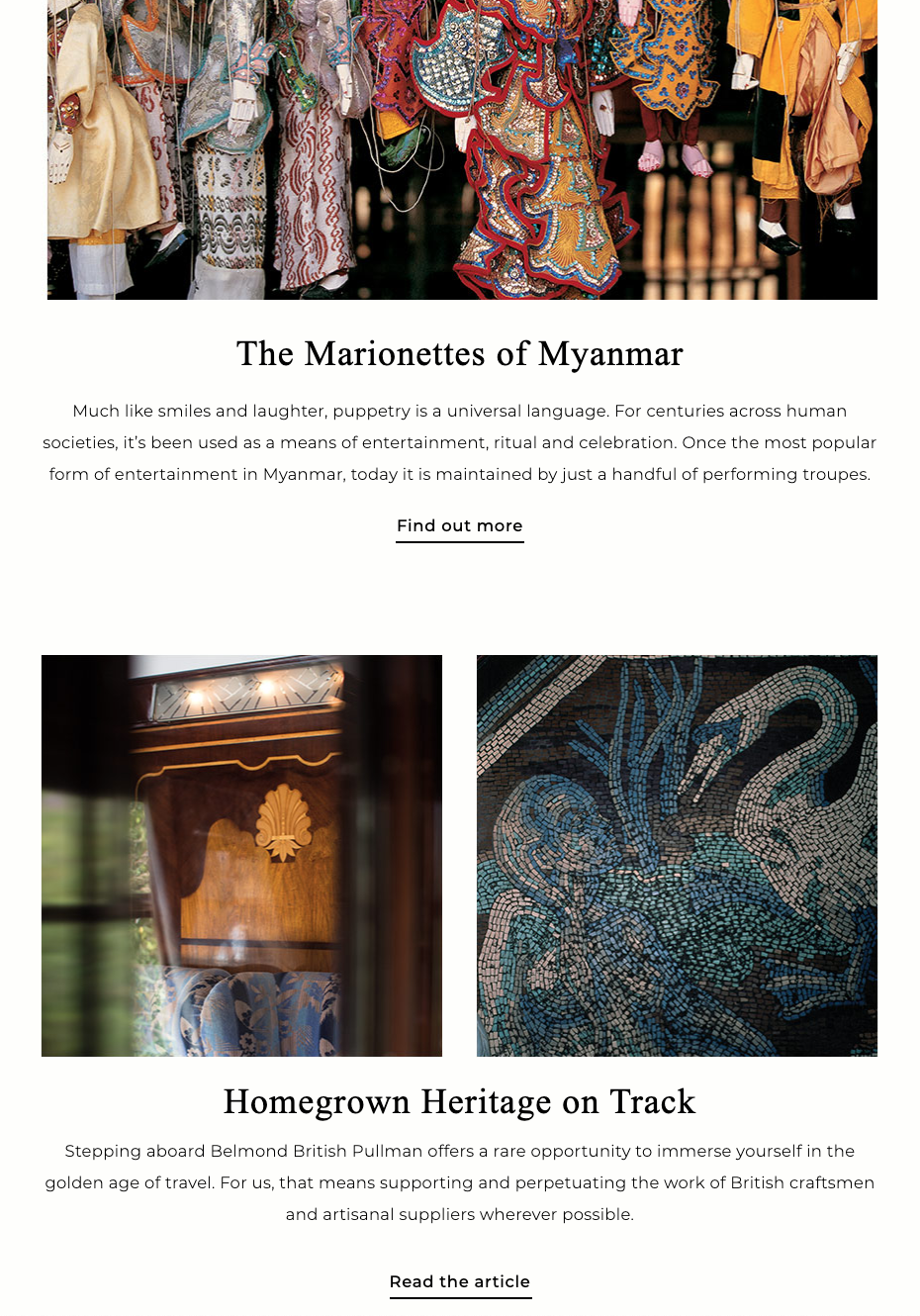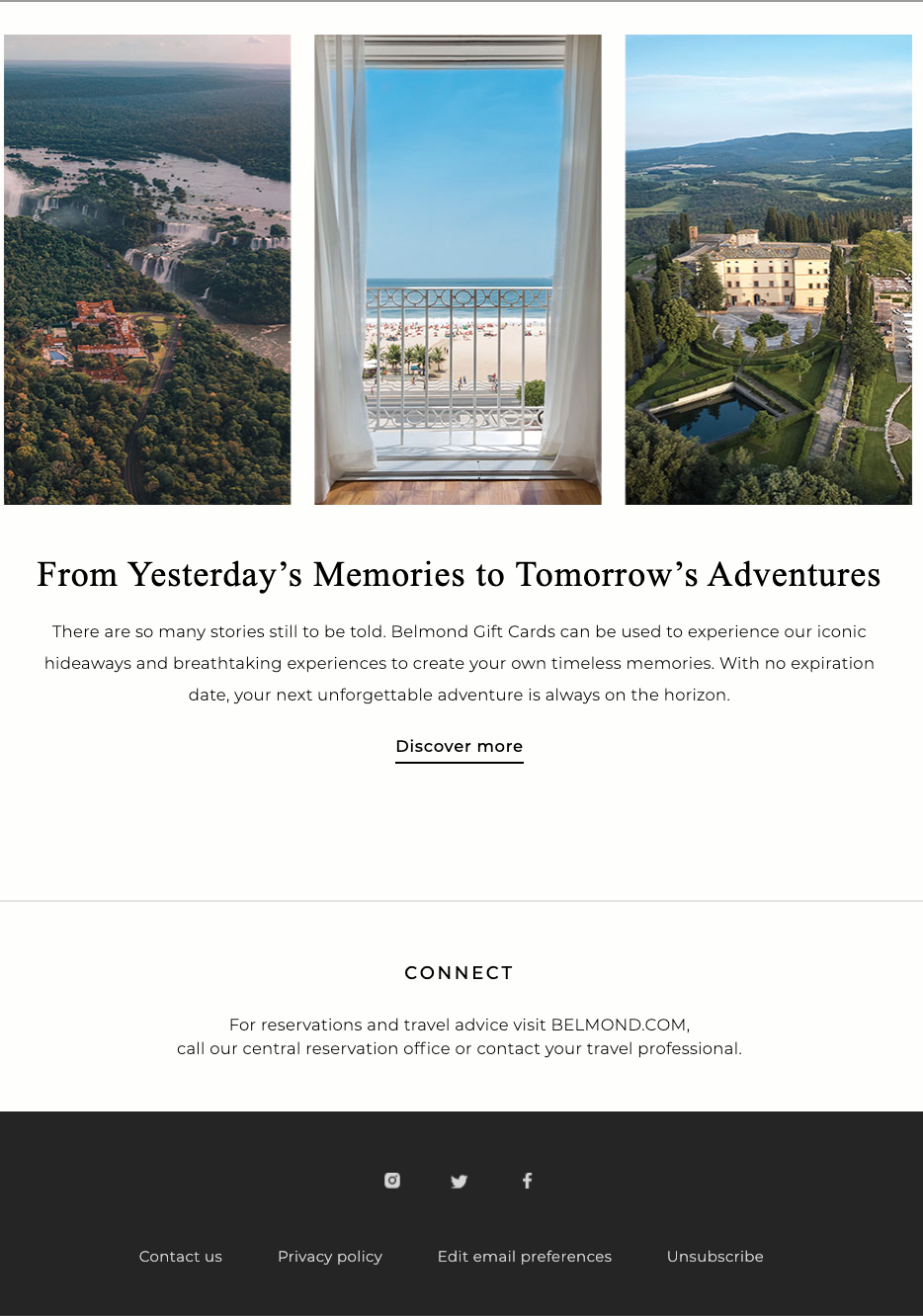Hotel Email Marketing: 8 Emails Your Hotel Should Send to Guests
How does your hotel use email marketing to communicate with guests?
If you’re like most busy hoteliers, you probably have a few email templates set up on auto-pilot: a booking confirmation, a pre-stay reminder, and of course, a post-stay receipt. Most hotel email campaigns follow those three basic formats.
Those three emails have one thing in common: They’re only triggered when someone makes a booking — so they’re not exactly driving any additional revenue.
I’ve written before about email marketing, specifically, how to grow your hotel’s email list.
If your email list is growing right now, congrats! Let’s talk about how to approach your hotel email copywriting in a way that nurtures those fresh leads and get folks excited to book your property. In this article, I’ll share eight different types of emails your hotel should send to guests.
What is hotel email marketing and why does it matter?
Believe me, I see the appeal of automating your basic email campaigns and moving on to tackle everything else on your to-do list. Your time is spread thin enough as-is!
Even with GDPR regulations in Europe, email marketing is the channel that consistently delivers the best ROI across multiple sectors, generating around $40 for every $1 spent on average.
That said, email marketing is not without its challenges.
In the accommodation industry, including hotels and B&Bs, research showed the average email open rates were 15.8% while the average click-through rates were just 4.7%.
You might be thinking right now, “Ugh, aren’t marketing emails kinda spammy?”
Let’s talk about what hotel email marketing actually is — and what it isn’t.
Effective hospitality email marketing isn’t about bombarding anyone’s inbox with useless content. Rather, try think of it as part of their customer journey.
You’re already creating a memorable guest experience once they arrive on your property — why not get it started before your guest even enters the lobby?
As with all things in marketing, it comes back to understanding the guest’s point of view. Remember, if they’re on your email list, they’re already dreaming and thinking about traveling to your destination. Email is a great way to help build that anticipation and excitement.
Having a thought-out email marketing strategy is one thing, but actually writing engaging emails to prospective hotel guests is another. (Psst… Don’t forget, I can help you out with hotel email copywriting.)
Some quick rules of thumb:
Keep your hotel’s brand voice and personality consistent
Subject lines should be short and pique curiosity (a lot of people check their email on mobile!)
Limit the number and size of embedded images (many email providers don’t automatically allow images to load from external addresses, so they might not be viewable anyway!)
Now that we understand why email marketing is important for hotels, let’s talk about your content plan.
Yep, email campaigns are content, too — and you should be communicating with your customer differently, based on where they are in the process of booking.
That journey takes your customer through three phases: before, during, and after their stay. In these phases, you’ll find your pre arrival emails, post stay emails, and newsletter-style communications.
Pre-Arrival Emails That Build Trust (and Get Upsells!)
1. The Confirmation Email
The “confirmation email” is the first email that we all expect to receive after booking a hotel.
Hotel guests will often wait for this email as a sign that their booking has been processed or confirmed. Honestly, this one’s kind of the bare minimum, in terms of emails we should send our guests. But it’s still a valuable and important message to send.
For most hotels, this email is automatically generated by your CRM software.
(In fact, your CRM probably has a bunch of pre-made hotel email marketing templates already locked and loaded for you to use.)
Like anyone else, I’ve booked my fair share of hotel rooms. If, for whatever reason, I didn’t receive this confirmation email after handing over my credit card info… well, needless to say, I wouldn’t feel great! Anyone in a similar situation would be on the phone with reservations or customer support ASAP to make sure that booking went through.
Some other things you may want to include in your confirmation email:
Your hotel’s check-in and check-out times
The date of arrival
Number of nights booked
Room type reserved
Price of the stay, including taxes and/or resort fees
Directions to the hotel
It’s also a good idea to include restaurant hours and/or any package inclusions, like breakfast or transportation.
Making this initial contact with your guest in a prompt manner puts their mind at ease. Think of it as a hotel introduction email… its is a good starting point for your email marketing strategy because it builds trust.
2. The Preference Email (aka the Upsell Email)
What’s the best way to ensure your hotel guests have everything they could possibly need or want during their stay? Well, you could ask them ahead of time, by sending a pre-arrival preference email.
Sending an arriving guest a preference email demonstrates that you care about their experience, before they’ve even stepped foot in your lobby.
Not only does this message show that you have their interests in mind, but it also sparks excitement for their stay!
Use this email as an opportunity to learn more about the guest. Ask if they have any allergies or personal preferences, such as feather vs down pillows. Ask if there is anything that the hotel needs to know about in advance of their arrival, or simply ask if there’s anything your hotel can do to exceed their expectations.
While I’m referring to this a “preference email,” it’s also an opportunity to drive more revenue through upselling.
Use this email to offer additional services to personalize their stay, such as a spa treatment, a bottle of champagne on arrival, airport transfers, local tour experience, or even room upgrades.
According to GuestJoy’s hospitality industry upselling report, wellness offers like spa treatments or massages were generally the most popular with guests, amounting to 20.4% of all services sold in 2019.
Of course, not every hotel has a spa!
GuestJoy reports that room upgrades were a close second, making up 20.2% of all items sold. That’s followed by taxi services at 18% and restaurant sales with 16%.
Asking guests about their personal preferences shows that you care about making their experience a great one.
It’s also a tool to gather valuable information about your guest and even add revenue using an upsell — your revenue management team will thank you! 😉
3. The Pre-Arrival Reminder Email
Sending a final reminder 1-2 days prior to your guest’s arrival is often automated by a CRM, but a pre-stay reminder email can be more useful than you might think.
This is also a piece of your email marketing strategy that your customers expect. So although it might sound obvious or boring, it’s absolutely necessary.
Think about it this way:
This reminder email is your LAST digital touchpoint before that guests walks in.
This is your last chance to confirm any specific preferences they’ve provided you — and let them know what to expect. This can be as simple as mentioning that their preferred feather pillows are ready and waiting for them in the room, or making sure they’re up-to-date on your hotel’s COVID-19 policies.
If the guest chose to take advantage of an upsell offer, make sure this is confirmed, too.
Email is an important channel to consider in your hotel marketing plan.
Make sure you’ve included hotel email marketing campaigns in your wider business strategy with my free template below. ⤵
Post-Stay Emails That Every Hotel Needs To Send
4. The Thank You Email (Folio or Receipt)
Upon checking out, your guest receives a final bill and pays for their stay. Usually, we also email that folio as a receipt and thank the guest for their stay.
Much like the initial booking confirmation email, this is sort of a formality — but it’s also a customer expectation that shouldn’t be skipped.
I strongly recommend incorporating a more personal message into this email, beyond just, well, an itemized bill.
Remember that they had a choice and they chose your property over allll the other options. 😊
Always thank the guest for staying with you! Last impressions count, too… but hey, spoiler alert: This shouldn’t be the last communication you send a hotel guest.
5. The Feedback Request Email (“Leave Us a Review”)
After the upsell/preference email, I’d wager this one is among the most powerful emails you could send a guest.
Online reviews are today’s word-of-mouth marketing.
The vast majority of consumers still say they check online reviews prior to booking a hotel. Surveys show that when searching online, 88% of travelers filter out hotels with an average review rating below three.
Asking a hotel guest for their feedback is best done about 24 hours after the guest has checked out — you want to ensure their stay is still fresh in their mind, but give them enough time to get home or settled into their next destination.
But make it easy for them, too.
Include a link directly to your TripAdvisor profile, Google listing, and/or Facebook page and let the guest know that they are invited to share their experience wherever they prefer.
If you’re reading this blog, I reckon you already know how important reviews and constructive feedback are to the hotel industry.
Don’t miss out on the chance to get more positive reviews. Make sure to include this step in your email marketing strategy.
6. The Loyalty Email
To increase a customer’s lifetime booking value, you of course need them to stay with you more than once!
The “loyalty email” is basically an invitation to stay with you again. In it, you’ll recognize and show appreciation for their continued loyalty to your hotel — while enticing them back.
Now, the timing of this one can vary… and it helps a lot to use an email provider that syncs up with your CRM or property management system.
(Psst... you can see what I recommend in this article on marketing for a hotel. Jump to Part IV on the best tools and resources!)
If you have a guest who has stayed at your hotel before, look for patterns:
Do they often book last-minute weekend trips in the summer?
Do they come to your city for business once a quarter?
Do they come to your hotel every year on a special occasion, like a birthday or anniversary?
Email marketing automation is powerful.
With the right email marketing tool, you can set up email campaigns that trigger an “invitation to return” and time it within that guest’s typical booking window.
You could apply similar logic and automation to a first-time guest, though it’s not always as effective without an established pattern of stay.
If you need to, you can always offer a special rate or loyalty perk, to sweeten the deal.
We’re almost done — sit tight, there are TWO more types of emails you need to send your hotel guests!
Using Newsletters to Engage Your Audience
The pre- and post-stay emails I’ve mentioned so far are actually pretty easy to automate. Each one also follows a clear template, as far as what hotel guests expect to receive.
Your hotel newsletter can be a lot more creative.
I should mention, though, that not every hotel needs to send out an email newsletter…
Much like deciding whether to add a blog to your hotel website, the decision has its pros and cons.
First, ask yourself:
Does my hotel have enough content for this?
Does my hotel have an audience for this?
Do I have the time and resources to create this, consistently?
It’s up to you and your team to weigh these questions!
We all want to work smarter and not harder, so don’t be afraid to repurpose. The content you create for email marketing campaigns should ladder up to your wider hotel marketing plan — meaning it should easily be repurposed for your website, blog, social media, and other platforms.
Your email list is also one of your most valuable digital marketing assets. But if you don’t communicate with your list consistently, it’s just going to sit there, gathering dust.
When the time comes for you to drop a majorly exciting new offer or say, reopen your hotel post-COVID, your subscribers will have forgotten all about you. 😢
You need to communicate with your customers, even when you don’t necessarily have something to sell them.
This is why the “newsletter” email is SO valuable.
Let’s talk about two different types of hotel email newsletters: the more general, lead-nurturing message and a more sales-driven message.
7. The “Inspirational” Email Newsletter
When I wrote about using a lead magnet to grow your hotel’s email list, the most popular suggestion by far was to create a local destination guide.
In a lot of cases, potential hotel guests are poking around your website because they’re interested in visiting your destination — as a tourist, event attendee, or maybe on business.
It’s pretty safe to assume they’d like to know what’s going on and what to do there. That’s why an “inspirational”-style newsletter email with local tips and advice can be so effective for hotels.
Emails #1-6 on this list are all reactive and tied to a specific customer booking. You can’t neglect proactive email marketing though… sending out a regular newsletter is a great way to nurture leads BEFORE they’ve decided to make a booking.
Your “inspirational” newsletters can inform or entertain subscribers who might live near or far — but I’ll explain more about engaging the local market in a moment.
There’s really no right or wrong way to send a newsletter, but being consistent is key.
Decide for yourself how frequently you can send it out — weekly, biweekly, or monthly are all fine options as long as you maintain a consistent schedule and content format.
If you’re sending it weekly or biweekly, limit your newsletter content to one main “story” or call-to-action, so you don’t overwhelm your subscribers.
If you’re sending it monthly, I recommend adding a bit more bulk!
Since you’re not communicating as frequently, there’s a little more wiggle room in a monthly newsletter to share multiple stories — and even blur the lines between a lead-nurturing “inspirational” message and a sales-driven “promotional” message.
I always suggest deciding on a format, though, and sticking with it. Take a look at these hotel newsletter examples for some inspiration.
One newsletter I actually look forward to reading each month is from Belmond. (No affiliation!)
Peek at the screenshots below to get a sense of how Belmond uses luxury brand copywriting to engage their target audience:
What do all these examples have in common?
Consistent branding and a clear format. Your email marketing software of choice should be equipped with multiple newsletter templates that you can customize to fit your brand and content.
This type of email newsletter is about engaging with folks who haven’t made a purchase with you yet.
So what should you send them at this stage? Here are a few ideas:
Concierge tips, like new restaurants, boutiques or other openings nearby
Short travel itineraries to inspire the planning phase
Local updates related to safety and COVID-19
Case studies from past event planners
Venue tips or design trends from your wedding specialist
If you still find yourself feeling a bit stuck on what to send, I’ve previously shared 101 hotel content ideas — perfect for your “inspirational” emails, your blog, or social media.
8. The “Promotional” Email Newsletter
The main reason I chose to separate newsletter emails into two distinct types is this: I strongly recommend getting on a weekly or biweekly schedule.
With that sort of frequency, you need to limit the amount of content to avoid coming across spammy.
Keep it simple and provide value.
If you’re consistently providing value, your subscribers will grow to trust you. They’ll look forward to hearing from you and be more receptive when it does come time to offer a promotion or package.
The 80:20 rule is a good rule of thumb. Provide value 80% of the time and sell 20%.
When you do send out a promotional newsletter, make sure the offer is timely and time-sensitive.
This doesn’t have to be limited to booking a room, either. In 2020 and beyond, travelers are very receptive to wellness and other local/experiential offers.
“But what about our restaurant?”
Real talk: a subscriber living thousands of miles from your hotel is not interested in your new brunch menu.
And that brings us to the importance of audience segmentation, which we’ll dig into deeper next.
Hotel Email Audience Segmentation: Locals vs. Tourists
We don’t talk to strangers the same way we talk to our best friend, right?
As hoteliers, we don’t communicate with the local market the same way we do with inbound tourists. This is where audience segmentation becomes a critical piece of hotel email marketing.
Think back to that “preferences” email, for example.
When you’re growing your hotel email list, there are many ways to gather communication “preferences” from your subscribers before they even stay. Consider:
What do your subscribers actually want to hear about?
Is this subscriber interested in booking a room or are they planning a wedding?
Does this subscriber live locally? Perhaps they’ve been to the restaurant/bar before?
All of these questions are excellent jumping-off points for audience segmentation.
Audience segmentation is essentially just putting your mailing list into specific, smaller lists based on their interests or some other factor.
There are all sorts of different audience segments your hotel might want to consider. If you have a large email database, you could easily end up with a dozen different segments.
If you’re just getting started with hospitality email marketing or have a small list, I want you to think about segmenting your audience a little more simply: local market and non-locals.
That’s because you can tailor your hospitality newsletters a lot better this way.
Generally speaking, folks living within the locality of your hotel are going to be more receptive to food and beverage offers than someone living outside your area.
This includes current deals available in your restaurant or bar, as well as private dining for special occasions. Birthdays, religious events, and in some cases, weddings, are often booked by the local market.
In times of COVID-related travel restrictions, you might also want to offer a locals-only rate or special hotel staycation offer.
You don’t want to send subscribers content that won’t be relevant to them.
Your email marketing strategy is going to look different when targeting tourists, including whether or not they’ve previously stayed at your hotel.
(That’s where your CRM software becomes important again, by the way! Remember email #6, the loyalty email.)
Other topics that make sense to communicate to your wider audience include more general offers and promotions, news related to renovations or refurbishment, and any new amenities opening soon at your hotel.
Finally, non-locals could still be interested in hearing about larger events like festivals and conventions, especially as these drive higher travel demand to your destination.
How to Grow Your Hotel Email List
Before you go, let’s make sure you have an email list to send all these fantastic emails to!
Watch the video below for a simple list-building strategy that actually works. ⤵
Final Thoughts
Since annual business planning is underway, it’s a good time to rethink your hotel email marketing campaigns. Here are the eight emails I believe every hotelier should be sending their guests:
Confirmation Email
Preferences and/or Upsell Email
Pre-Arrival Reminder Email
Post-Stay Thank You Email with Guest Folio
Request For Feedback/Review Email
Loyalty Email
Inspirational Newsletter Email
Promotional Offer Newsletter Email
With the help of a solid CRM, marketing and revenue management can really make a huge impact on the bottom line by collaborating on pre-arrival and post-stay emails. Always have your target guest audience in mind when creating any kind of marketing automation, including email.
Approach creating a hotel email newsletter with the same laser-like focus on your audience. Don’t be spammy and segment your email database by interests — or at least, separate the local market.
Hotel email marketing represents a valuable opportunity to engage with guests pre- and post-stay, while also building a relationship with potential new ones. If you need any help with your hotel email copywriting, feel free to get in touch.
What else do you want to know about email marketing in hospitality industry? Would it help if I shared a few hotel email marketing examples or created a hotel marketing email template?
Let me know in the comments below!
WHAT TO READ NEXT:
Lead Generation for Hotels: How to Create a Hotel Lead Magnet
Hotel Copywriting vs. Content Marketing: What's the Difference?
Updated: June 2023







